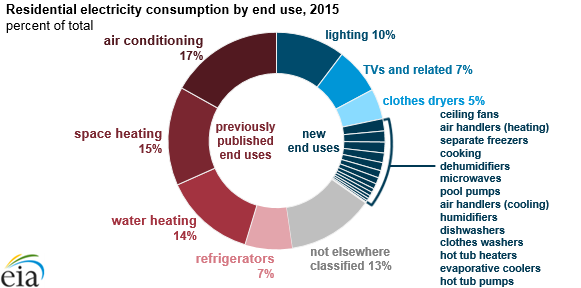
U.S. ENERGY INFORMATION ADMINISTRATION
WASHINGTON DC 20585
FOR IMMEDIATE RELEASE
May 31, 2018
EIA’s residential energy survey now includes estimates for more than 20 new end uses

Results from the 2015 Residential Energy Consumption Survey (RECS), released today by the U.S. Energy Information Administration (EIA), now include estimates of energy consumption for an expanded list of energy end uses. For electricity, the number of end uses estimated has expanded from 4 to 26 by adding estimates for equipment such as dishwashers, clothes washers, clothes dryers, televisions, and lighting.
The expanded end-use categories that consume electricity vary widely in how much energy they consume and how commonly they are found in the 118 million U.S. homes that are occupied as a primary residence. Lighting is used in all homes and consumes a substantial portion of electricity— 10% of the total electricity used in homes. Nearly every home had a television in 2015; only about 3% of homes had no television. Televisions and their associated peripheral devices such as set top boxes and internet streaming devices use 7% of the electricity used in homes each year.
Other equipment is relatively less common but can account for a larger share of electricity consumption in the homes that have them. For instance, only 7.9 million homes, or about 7% of the national total, reported using a pool pump. Nationwide, pool pumps consume 1% of the electricity used in homes, but among homes that have pool pumps, the equipment consumes 8% of total electricity consumed each year.
Refrigerator energy consumption and expenditures have been reported since the 1990 RECS. The 2015 estimates provide additional detail to this category, with separate estimates for the most-used and, in the homes that have them, the second-most-used refrigerator in a home. As a group, refrigerators use 7% of the electricity used. Most energy consumed for refrigeration is consumed by the most-used refrigerator in a home (77%), with second refrigerators consuming 18% of total refrigeration consumption nationwide.
New estimates are also available for other common electric appliances, including clothes dryers (5% of total electricity consumption), microwaves (1%), dishwashers (1%), and cooking (1%), which collectively covers stoves, ovens, and cooktops. For dishwashers and clothes washers, the estimates cover only the electricity used to operate the equipment and not the energy used to heat the water drawn by these appliances; that energy would be accounted for in the estimate for water heating.
These end uses and the other previously itemized estimates collectively cover 87% of residential electricity use. The remaining category “not elsewhere classified,” now comprises only 13%, and combines a number of end uses that were not publishable individually, such as computers, smartphones, and small kitchen appliances, as well as consumption from end uses not captured on the RECS Household Survey.
From 1990 through 2009, RECS estimated consumption and expenditures for four end-use categories: space heating, air conditioning, water heating, and refrigerators; the remainder was aggregated as other. In 2015, nearly half of residential electricity consumption fell into this other category. As certain appliances and equipment have become more prevalent in homes, this remainder category became a larger share of residential energy consumption, especially for electricity.
More detail is also available for natural gas and propane end uses. For natural gas, the 2015 RECS provides expanded estimates for natural gas cooking, clothes dryers, pool heaters, and hot tub heaters. For propane, the new end uses detailed are clothes dryers and cooking. These data are available in tables as well as a microdata file.
Before 2015, previous RECS surveys used statistical regression models to disaggregate a home’s energy consumption across published end uses. With the 2015 study, EIA transitioned to using engineering models which incorporate more information and usage behavior from the RECS Household Survey, from equipment specifications, and from research, to produce improved estimates of energy consumption of devices in homes.
This improvement in methods for energy allocation affects comparisons with prior RECS. In order to assist data users interested in analyzing the time series of end-use consumption, EIA has published a brief report describing how this change in methodology has affected end-use estimates. EIA has also updated the methodology report for this survey to provide more information on the consumption data collection and end-use estimation approach.
EIA Program Contact: Chip Berry, 202-586-5543, James.Berry@eia.gov
EIA Press Contact: Jonathan Cogan, 202-586-8719, Jonathan.Cogan@eia.gov
EIA-2018-04
